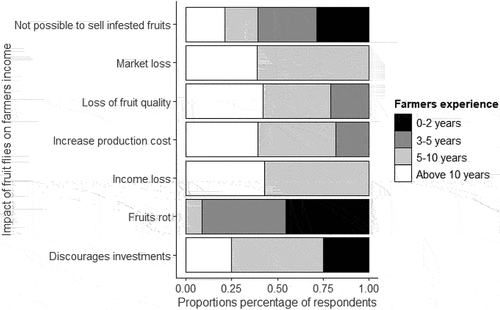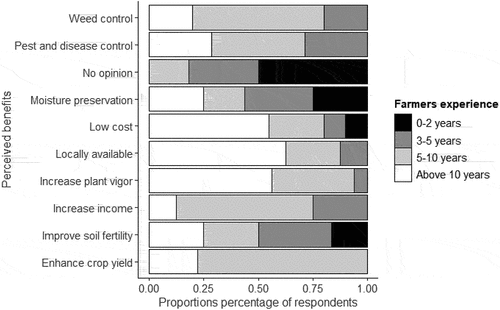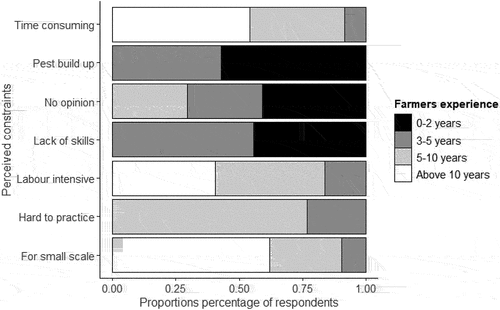 ?Mathematical formulae have been encoded as MathML and are displayed in this HTML version using MathJax in order to improve their display. Uncheck the box to turn MathJax off. This feature requires Javascript. Click on a formula to zoom.
?Mathematical formulae have been encoded as MathML and are displayed in this HTML version using MathJax in order to improve their display. Uncheck the box to turn MathJax off. This feature requires Javascript. Click on a formula to zoom.ABSTRACT
Agroecological farming emerges among approaches for managing crop pests including the “True” fruit fly (Diptera, Tephritidae). We conducted baseline interviews and field experiments in Eastern Central Tanzania to determine farmers’ perception on the approach and verify its socio-economic performance in cucurbit crop production. The performance of small-scale cucurbit farming in agroecological and conventional agriculture was broadly comparable. Farmers perceived the approach as effective and beneficial over conventional farming and pesticide-based agriculture but constrained by its more elaborate/laborious implementation. Still, agroecological farming significantly lowered the production costs. Therefore small-scale agroecological cucurbit farming in Tanzania represents a viable alternative and promising tool to reduce use of synthetic pesticides that negatively impact human health and the environment.
Introduction
Cucurbitaceous plants are among the major fruits and vegetable crops cultivated throughout the tropical world. Their production contributes to food security and is an essential source of nutrients and vitamins and income generation (Mbega and Mabagala Citation2012) and contribute to good health and well-being. Based on statistics from the National Bureau of Statistics in Tanzania, watermelon is the most productive cucurbit crop, yielding an impressive 68,469 tons annually, with pumpkin following at 19,439 tons and cucumber producing 5,489 tons. The Central Eastern Zone is a significant contributor to the cultivation of these crops. The most cultivated cucurbit crops by farmers in Central Eastern Tanzania are cucumber (48.6%), pumpkin (24.6%), watermelon (21.7%), and squash (5.1%) (Bakengesa et al. Citation2023).
Cucurbit production faces different challenges, which are mainly represented by insect pests and plant diseases. Materu et al. (Citation2018) have reported that aphids (Hemiptera, Aphididae), striped cucurbit beetles Acalymma vittatum (Fabricius), Coleoptera, Chrysomelidae), and melon flies (Zeugodacus cucurbitae (Coquillet), Diptera, Tephritidae) are among the pests that pose a threat to cucurbit crops. The true fruit flies (Diptera, Tephritidae) are one of the most critical pest groups that have significant socio-economic implications such as the increase in production costs and reduced production (De Meyer et al. Citation2015; Mwatawala et al. Citation2010).
Many farmers in sub-Saharan countries, including Tanzania, employ synthetic chemical pesticides (Bakengesa et al. Citation2023; Mwatawala et al. Citation2015) as their principal control strategy for fruit flies. These pesticides pose significant health risks to producers and consumers and negatively impact the environment and biodiversity (Breman Citation2013). Toxic chemical residues in horticultural products, particularly cucurbit vegetables and fruits, have already resulted in such products being rejected before distribution in international markets (Mwatawala and Yeyeye Citation2016; Mwatawala et al. Citation2015; Virgilio et al. Citation2010).
In Tanzania, smallholder farmers can be roughly divided into two and partially overlapping categories; those with such a low income that they cannot afford chemical pesticides and fertilizers; and those who have access to and actively rely on synthetic pesticides. Both these categories seem to have relatively limited awareness of alternative farming practices, including agroecological crop management (Bakengesa et al. Citation2023; Constantine et al. Citation2021).
According to Mwatawala and Yeyeye (Citation2016), a significant proportion of farmers who opt for industrial agricultural products find biopesticides and biofertilizers of less practical use, mainly due to the time-consuming procedures associated with their preparations. In this context, farmers are constantly looking for economically sustainable approaches to maximize crop production. Mwatawala and Yeyeye (Citation2016) reported that a relevant proportion of Tanzanian farmers struggle with the production costs associated with conventional farming. Also in this case, these costs are often unaffordable for the lowest-income farmers.
To manage cucurbit flies and other tenacious pests, sustainable solutions such as agroecological farming strategies have been advocated (Deguine Citation2017). In East Africa, more and more farmers, NGOs, governments, and international organizations are acknowledging the advantages of agroecological farming. A variety of initiatives, projects, and training programs have been launched to encourage the agroecological transition and promote food security with zero hunger and no poverty. Local adaptations of innovative techniques, including climate-smart agriculture, conservation agriculture, and organic farming, are being explored. Unfortunately, the potential for widespread and enduring implementation of agroecological practices is curtailed by inadequate policies, infrastructure, extension services, and market connections (Breman Citation2013). In Tanzania, agroecological farming is still in its early stages. However, there are encouraging signals about the suitability of this approach as a valuable tool to increase food security, reduce poverty, and environmental and economic sustainability. To scale up agroecological practices and foster a more resilient and inclusive agricultural system, it is crucial to continue investing, collaborating, and supporting agroecologically-oriented policies (Milheiras et al. Citation2022; Tryphone and Thomas Citation2023).
Agroecological farming practices that include bio-pesticides, bio-fencing, intercropping with unpalatable host crops and orchard sanitation are effective in the pest management of the true fruit flies (Deguine et al. Citation2015). The agroecological farming system is an effective and cost-efficient measure to attain sustainability in agriculture (Deguine Citation2017), human health and the environment. The agroecological approach heavily relies on locally available resources and technologiesand, as such, is less subjected than conventional agriculture to non-local processes, which might affect the international market. Agroecological farming practices are biodiversity-friendly, improve the physical characteristics of soil, and produce crops that are considered to be of higher quality when human health and environmental impacts are considered (Giraldo Citation2019).
Regardless of agroecological agriculture being widely perceived as “better,” the development of collective, economic organizations among agroecology-oriented farmers remains sluggish (López-García and Carrascosa-García Citation2023). Most importantly, its socio-economic impact and its production costs are often only vaguely defined. This is particularly true for small-scale cucurbit production in Africa. For this relevant sector of Tanzanian agricultural production, we can already rely on guidelines for the pest management of the true fruit flies by Deguine et al. (Citation2015) and Deguine (Citation2017), and on quantitative data about the awareness of its benefits/shortcomings perceived by Tanzanian small-holders (Bakengesa et al. Citation2023).
With the objective of providing relevant information to governmental and non-governmental actors of possible use for scientifically driven policies in support of sustainable development and climate action, here we provide a first quantitative description by employing both field surveys and field experiments on how the adoption of agroecological practices affects the productivity and income of smallholder cucurbit farmers; This first test-case could be replicated on other crops and provides a more structured framework in support of food security and economic growth in Central Eastern Tanzania to ensure sustainable cities and communities.
Materials and methods
Experimental setup
The research was carried out in the Morogoro region (Central Eastern Tanzania), in an area between latitudes S5°58’-10°0’ and longitudes E35°25’-38°30.’ The area is characterized by three main agroecological zones: (a) river basins (<300 m above sea level) with average rainfall 900 mm − 1400 mm per year; (b) plateau (300-600 m above sea level), 700 mm-1200 mm per year; and (c) mountainous (>600 m above sea level), with average rainfall 800 mm − 2500 mm per year. The region is characterized by dry and rainy seasons with bimodal rainfall patterns and typical minimum and maximum temperatures ranging from 16 to 33°C (Ernest, Nduganda, and Kashaigili Citation2017). The study was conducted only in the plateau and mountainous zones and not in the river basin because there are no main cucurbit production activities in that zone.
The socioeconomic impact of fruit flies on rural farming communities was evaluated both via a baseline survey and through field experiments to estimate productivity and production costs in agroecological and conventional farming.
A field survey based on a semi-structured questionnaire (Supplement A) was implemented to collect information on the perceived impact of fruit flies on farmers’ income and the perceived benefits and constraints of agroecological farming practices. A set of questions was asked to define the demographic composition of cucurbit farmers in the area, the cucurbit crops cultivated, the agricultural practices implemented, and the awareness of fruit fly pests in agroecological farming practices. In this context, we characterized the income impact. The survey involved cucurbit growers identified both with the assistance of agriculture extension officers and through a snowball sampling method (Bellon Citation2001) where the interviewed farmers recommended others growing similar crops in the area. The interviewed women and men had different social backgrounds, ages and education. They acquired knowledge of agroecological farming through various means, such as learning from their neighbors, personal experience, agriculture extension officers, media, NGOs, and training opportunities. Following Wonnacott and Wonnacott (Wonnacott and Wonnacott Citation1990), the sample size and number of farmers to be interviewed were calculated as , with n = number of interviewed farmers, z = value for 95% confidence, p = estimated proportion of farmers in the area (set to 0.9), Q = margin of error at 5%.
Cucurbit production was monitored through a field experiment implemented between 2021 and 2022 during two cropping seasons per year. Twenty experimental fields distributed between the plateau and mountainous zones of the Morogoro area were randomly assigned to agroecological farming (biofertilizers and biopesticides, mulching, bio-fence, and intercropping), or conventional farming (industrial fertilizers and pesticides) as detailed in Supplementary Material B. In each field, three types of crops were grown in 15 m × 15 m plots: cucumber (Cucumis sativus L.), watermelon (Citrullus lanatus (Thunb.) Matsum. and Nakai), and squash (Cucurbita moschata Duchesne ex Poiret) with a planting distance of 1 m × 1.5 m. For each crop, in each field, the growth of 40 tagged plants was followed by measuring the number of fruits set, aborted and damaged. The total yield (ton/ha) and the farmgate price for each crop were quantified for each farm and the costs of spraying materials (organic and industrial insecticides and fertilizers) were used as proxies for the production costs of agroecological and conventional cucurbit farming.
Data analysis
The R packages (R Core Team Citation2010) sjPlot (Lüdecke Citation2018) and summary tools (Comtois Citation2019) were used for the analysis of survey data. Contingency chi-square tests allowed for verifying relationships between farmers’ perceptions and experiences. The data from the field experiments were analyzed through analysis of variance using Package Agricolae and GAD and allowed verifying the difference of fruit set and abortions, yield and economic benefits of cucurbit crop production under different management practices and years of production. Means were compared using the Tukey HD test and the Student-Newman-Keuls test. The assumption for normality was tested by the Shapiro and Cochran test and the data that did not meet the assumption for normality were square root transformed. The cost-benefit ratio from each management practice was quantified following Baranchuluun, Bayanjargal, and Adiyabadam (Citation2014) and calculating Benefit-Cost Ratio: BCR= PV(B)/PV/(C), with BCR=, PV=the Present Value, B=Benefits, C=Costs. Gross revenue was calculated as the income value of total sales; gross margin is the amount of profit from its revenue calculated as gross revenue minus total production costs. The return-on-investment percentage was calculated as the net return on investment divided by the cost of investment times a hundred.
Results
Field survey
A total of 138 cucurbit farmers from three districts of the Morogoro Region, Kilosa, Morogoro, and Mvomero, were interviewed. The results showed that fruit flies were the cucurbit pests most commonly observed by farmers.
Perception of the impact of fruit flies on farmers’ income
The farmers’ perception of the effects of fruit flies on their income significantly differed with the number of years of experience in cucurbit production (χ2 = 71.228, df = 18, p = 0.000). The majority of less experienced farmers (i.e. with less than 5 years of experience) reported that fruit rot due to fruit fly larvae was the primary negative impact on their income. Most experienced farmers attribute fruit fly damage to loss of income and market value of fruits. Only cucurbit farmers with at least 10 years of experience did not associate fruit flies with fruit rot (). The farmers’ education level, sex and age did not affect their perception of the effects of fruit fly pests. Regardless of their experience, all farmers mentioned the impossibility of selling damaged fruits as one of the limitations.
Perceived benefits of agro-ecological farming practices
The farmers’ perception of the benefits of agroecology varied significantly with their experience in cucurbit production (χ2 = 75.131, df = 27, p < 0.001). Regardless of their experience, farmers mentioned improved soil fertility and moisture preservation as the main benefits of agroecological practices. Less experienced farmers did not express an opinion on the benefits of agroecology. As production experience increased, a larger proportion of farmers associated agroecology with improved soil fertility. With further increase in experience, farmers indicated local availability of required inputs as the main benefit of the system (). Education level, sex, and age did not significantly affect the perception of growers about the benefits of agroecological farming.
Perceived constraints of agroecological farming practices
The farmers’ perception of the limitations of agroecological farming, compared to conventional practices, differed significantly with their experience in cucurbit crop production (χ2 = 78.410, df = 18, p < 0.001). The majority of less experienced farmers perceived pest buildup as the most relevant problem of agroecological practices. More experienced farmers acknowledged the lack of skills in implementing agroecological methods as a main drawback and further claimed that the system is mostly applicable at a small scale (). Education level, sex, and age category did not significantly affect the perception of cucurbit growers about the constraints of agroecological farming practices.
Field experiments
Abundance of set and aborted fruits
The abundance of set and aborted fruits showed different patterns in different crops. The number of fruit sets in cucumber, squash and watermelon were significantly affected by the interaction of year of production and management practice (, ). Differences between agroecological and conventional farming were observed only during the second year of production. However, while squash and watermelon showed significantly higher numbers of fruit sets in agroecological plots, cucumber, showed the opposite pattern with a higher abundance of fruit sets in conventional plots in the first year of production.
Figure 4. Number of fruit sets in cucumber, squash and watermelon across two consecutive years in agroecological and conventional farming. Significance letters refer to the a posteriori comparisons for the significant interaction management x production year.
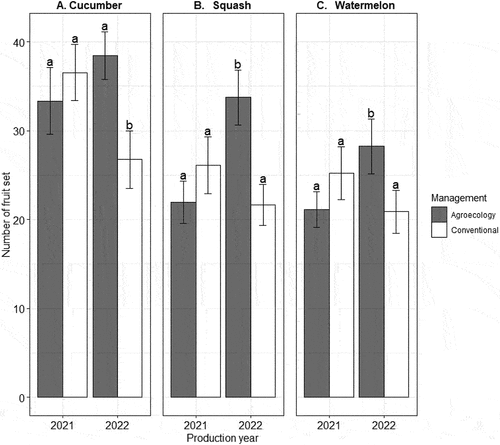
Table 1. Analysis of variance in the abundance of fruits set in agroecological and conventional cucurbit farming.
Also, the observed number of aborted fruits varied significantly () across years of production and management practices, with different patterns observed between crops (). In this case, cucumber and watermelon showed differences only during the first year of production, with a higher number of aborted fruits in agroecological plots, while squash only during the second year, with a higher abundance of aborted fruits in conventional plots.
Figure 5. Number of aborted fruits in cucumber, squash, and watermelon across two consecutive years in agroecological and conventional farming. Significance letters refer to the a posteriori comparisons for the significant interaction management x production year.

Table 2. Analysis of variance on abundance of aborted fruits in agroecological and conventional farming.
Abundance of damaged fruits
In all three crops, the abundance of damaged fruits varied significantly across years of production and management practices (). In cucumber, differences were also observed between altitude, with higher abundances of damaged fruits in the plateau zone. Cucumbers showed differences only during the first year of production, with a higher number of damaged fruits in agroecological plots, while squash only during the second year, with a lower abundance of damaged fruits in agroecological plots. Watermelon showed more complex patterns with abundances of damaged fruits significantly higher in agroecological plots during the first year, and significantly lower during the second year ().
Figure 6. Number of damaged fruits in cucumber, squash and watermelon across two consecutive years in agroecological and conventional farming. Significance letters refer to the a posteriori comparisons for the significant interaction management x production year.
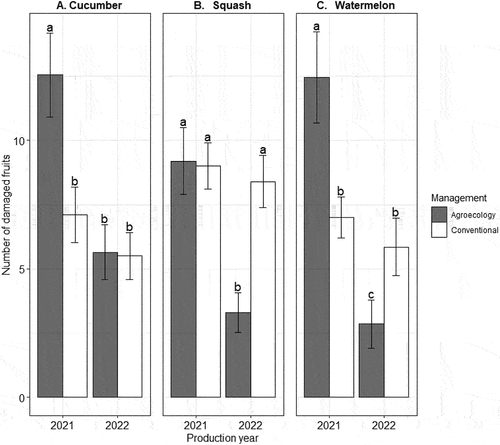
Table 3. Analysis of variance on the abundance of damaged fruits in agroecological and conventional cucurbit farming.
Total yields, gross revenue, gross margin and production costs
The average total production produced in agroecological and conventional plots was 5094.3 kg/ha:4188.8 kg/ha for cucumber 15,600 kg/ha:20408.8 kg/ha for watermelon, and 5780.6 kg/ha:6396.4 kg/ha for squash.
Total cucumber yields showed a significant interaction between management practices and year (), related to higher yields in agroecological production during the second year ().
Figure 7. Total yields of cucumber, squash, and watermelon, across two consecutive years in agroecology and conventional farming. Significance letters refer to the a posteriori comparisons for the significant interaction management x production year.
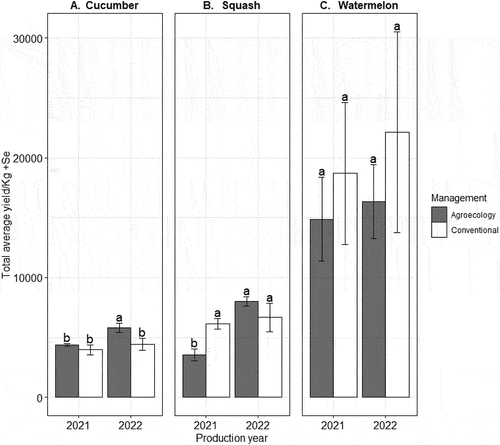
Table 4. Analysis of variance on total yields in agroecological and conventional cucurbit farming.
In squash, we also observed a significant interaction between management practices and year () due to the lower yield in agroecological production during the first year (). In watermelon, we did not observe significant differences across any of the factors tested.
The gross margin of cucumber was significantly affected by crop management () with a significantly higher gross margin observed in the agroecological production. shows how the gross margins obtained from the agroecological plots significantly increased during the second year. The gross margin of squash was affected by the interaction between crop management and year (). Here we observed significantly lower values from the agroecological production in the first year and significantly higher values during the second year (). The gross margin of watermelon did not show significant differences across any of the factors tested.
Figure 8. Average gross margin and gross revenue in cucumber, squash, and watermelon, across two consecutive years in agroecological and conventional farming. Significance letters are indicated in case of significant interaction management x production year.
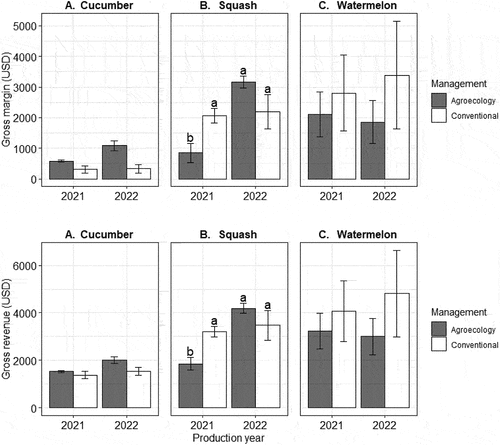
Table 5. Analysis of variance on average gross revenue, margin and production cost in agroecological and conventional cucurbit farming.
The gross revenue of cucumber had on the one hand significantly higher values during the second year of production and on the other, significantly higher values associated with agroecological production (). The gross revenue of squash was affected by the interaction between crop management and year (), with significantly lower values from the agroecological production of the first year and significantly higher values during the second year (). The gross revenue of watermelon did not show significant differences across any of the factors tested.
Squash, cucumber and watermelon showed significantly lower production costs in agroecological production ().
Figure 9. Production costs in cucumber, squash and watermelon, in agroecological and conventional farming.
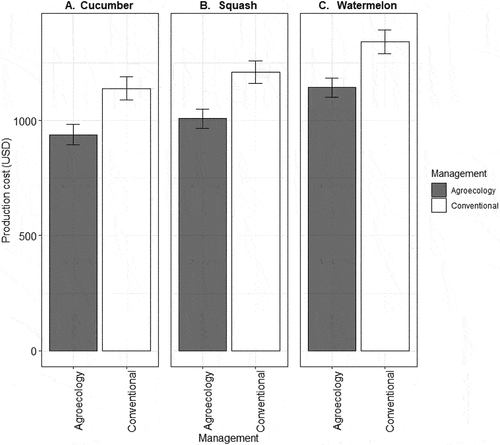
The average total cost of production estimated for agroecological management was 939USD/ha for cucumber, 1,145USD/ha for watermelon and 1,008USD/ha for squash. For conventional management 1,139USD/ha for cucumber, 1,342USD/ha for watermelon and 1210USD/ha for squash.
Cost-benefit ratio and percentage return on investment
The cost-benefit ratio (CBR) for agroecological squash, watermelon, and cucumber is 2.0:1.9:0.9, while is 1.8:2.2:0.3 in conventional plots. The percentage return on investment (ROI%) for agroecological squash, watermelon, and cucumber is 200:190:90, while is 180:220:30 in conventional plots.
The CBR and ROI% of squash were both affected by the interaction between crop management and year (), with significantly lower values from the agroecological production of the first year and significantly higher from the agroecological production of the second year (). Both CBR and ROI% were significantly higher in cucumber agroecological production, particularly during the second year of production (). No significant differences were observed in watermelon for these two metrics.
Figure 10. Cost-benefit ratio and percentage return on investment in cucumber, squash, and watermelon, across two consecutive years in agroecological and conventional farming. Significance letters are indicated in case of significant interaction management x production year.
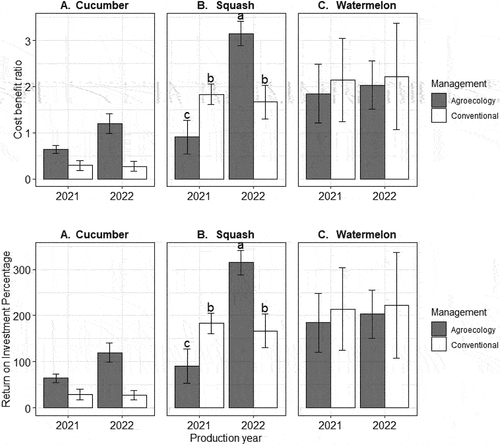
Table 6. Analysis of variance cost-benefit ratio and percentage return on investment under agroecological and conventional cucurbit farming.
Discussion
The impact of fruit flies reported by farmers includes loss of income due to fruit rotting and loss of market value, increased production cost due to using sprays and discouragement of farming investment. Cucurbit harvest losses due to cucurbit flies in the Morogoro area usually range from 30% at the start of the growing season to 80% by the end (Mwatawala et al. Citation2010, Citation2015). Aside from direct fruit damage, indirect losses are also connected with quarantine restrictions (Mwatawala Citation2016; Mwatawala et al. Citation2005; Mziray et al. Citation2010) imposed on vulnerable markets. Most farmers in the area use pesticides to control fruit flies, while only a few employ agroecological methods (Bakengesa et al. Citation2023). Therefore, there are increasing environmental and health concerns due to using harmful products (Nasiruddin et al. Citation2002).
The general benefits of agroecological farming that farmers perceive include more effective weed, pest, and plant disease control measures and higher income. Among them, efficient soil moisture preservation, lower production costs, local availability of agroecological fertilizers and pest control tools, increased plant vigor, and improved soil fertility and crop yield. Other studies also mentioned these benefits (D’Annolfo et al. Citation2017; Ochola et al. Citation2013). The research by Deguine (Citation2017) and Deguine et al. (Citation2015) indicates that regardless of agroecological farming practices being less profitable compared to conventional farming, quantifying the profitability of agroecological farming practices generally does not include valuable indirect benefits such as the improvement of soil fauna and nutrients. Nonetheless, educating smallholder farmers on the direct and indirect benefits of agroecological crop management is crucial for promoting the agroecological transition (Bakengesa et al. Citation2023) to ensure sustainable cities and communities with zero hunger and no poverty.
The interviewed farmers mentioned among the constraints of agroecological practices that they are more labor intensive for small-scale production, hard to practice and comparably more time-consuming. The study by D’Annolfo et al. (Citation2017) pointed out that labor demand in agroecological farming is lower compared to other conventional practices. As a result, scientists must grasp what farmers already know, do not know, or misunderstand about this critical issue because their experiential knowledge is essential for identifying novel solutions and developing acceptable sustainable agricultural systems (Ochola et al. Citation2013).
Farmers' experience in cucurbit production was the only significant predictor affecting the perception of cucurbit growers on the impact of fruit flies on their income and the benefits and constraints of agroecological farming. The farmers’ invaluable knowledge and experiences can substantially aid agricultural growth and adopting sustainable farming practices (Ainembabazi and Mugisha Citation2014). Farmers have amassed a wealth of practical knowledge through generations of hands-on engagement with the agricultural landscape and its processes. Farmers adopt ways to avoid hazards and maximize productivity as they constantly adapt their practices to changing environmental conditions. Sharing these adaptive practices with others can boost the collective resilience of farming communities to ensure zero hunger and contribute to agriculture’s overall sustainability and good health and well-being.
Agroecological farming seems to suggest some potential for enhanced fruit set (as observed in two of the three crops during the second year of production). Agroecological practices implemented and refined over time contribute to the gradual improvement of soil and ecosystem functions, increasing fruit set and yield stability (Deguine et al. Citation2015). An increased diversity and abundance of flower visitors can improve pollination services, resulting in better fruit set and increased crop yields. The study by Rweyemamu (Citation2022) reported that pollinators visited and spent more time on cucurbit flowers in agroecological compared to conventional and control plots. Agroecological farming often promotes biodiversity by integrating various crops, trees, and animals within the farming system. Diverse plant communities and beneficial insects can help in pollination, pest control, and overall ecosystem health, potentially reducing factors contributeing to fruit abortion (Hauser Citation2020). Besides, maintaining soil fertility through practices like cover cropping, composting, mulching and minimal tillage can reduce plant stress and promote plant growth that might reduce fruit abortion and increase fruit set.
Both agroecological and conventionally maintained plots had fruits with tiny black oviposition spots of fruit flies and clear signs of fruit fly damage. In this case, we also observed some signals of the benefits and effects of agroecological farming during the second year of production (again, on two out of the three crops). Fruit damage and infestations by fruit flies in La Réunion were less prevalent in agroecological plots than control plots, resulting in reduced crop losses (Deguine et al. Citation2015). The study by Kibira et al. (Citation2015) stated that using a combination of farming methods, parasitoids, orchard sanitation, bait application technique, and biopesticides in agroecological farming, would lessen crop losses due to fruit flies. The number of damaged fruits was lower in the plateau zone. Environmental factors can affect fruit fly populations and infestations that may influence fruit damage due to fruit flies and other growth parameters (Mwatawala et al. Citation2006; Sapkota, Dahal, and Thapa Citation2010).
Concerning yields, the agroecological and conventional plots did not show clear differences and, overall, had comparable crop production. The study by Deguine et al. (Citation2015) found that cucurbit production was maintained at a high level after the beginning of agroecological practices to control fruit flies in La Réunion. In agroecology, higher overall production (at the farm rather than crop level) is achieved through a varied range of agricultural goods and environmental services, which reduces crop failure risks in the long run (Silici Citation2014). The results by Deguine et al. (Citation2015) suggest increasing yields and decreasing cucurbit losses due to fruit flies under agroecological management. The data from other studies show that yields in well-established agroecological farms are higher compared to conventional farms. Adopting agroecological practices enhances yield (61%), profitability (66%), and labor productivity (100%) (D’Annolfo et al. Citation2017). Agroecological farming thus seems suitable for promoting cucurbit crop yield and offers a promising approach for the long-term sustainability of cucurbit farming that can contribute to good health and well-being.
The production costs for squash, cucumber, and watermelon are subject to significant variation based on management practices. Notably, agroecological production substantially reduces overall production costs for all three cucurbits. Combining compost with bio-pesticides reduces industrial input dependency and makes the agroecological approach more profitable by cutting chemical application costs (D’Annolfo et al. Citation2017).
The gross revenue of cucumber and squash in agroecological production had significantly higher values in the second year. Conversely, the gross revenue of watermelon did not display any significant differences across the tested factors. Agroecological production systems can potentially improve farms’ socio-economic performance (Mouratiadou et al. Citation2024).
Agroecological farming shows a higher cost-benefit ratio and gross margin compared to conventional farming of the two crops (cucumber and squash) but does not show clear advantages in watermelon. This difference can be associated with lower production costs, as highlighted in the study by Deguine (Deguine et al. Citation2015). The positive trend possibly observed in cucumber and squash during the second year of production suggests possible long-term potential and sustainability of agroecological farming practices in optimizing economic returns for farmers in terms of reduced input costs and increased yields. This is justified because reduced fruit fly infestation resulted in more marketable, higher-quality fruits, while reduced insecticide costs resulted in lower total production costs and increased net profitability. Ntonifor et al. (Citation2013) found that the cost-benefit ratios of employing synthetic pesticides or organic extracts were comparable, indicating that these choices can be used in conjunction to reduce reliance on possibly more dangerous chemical products. With agroecological farming, farmers make significant financial savings (Deguine et al. Citation2015) hence lessening poverty. This is due to the combined factors contributing to increased profitability while promoting environmental sustainability and social well-being (Hauser Citation2020).
The prices of the produced cucurbits under conventional and agroecological farming were comparable. The local market dynamics and competition may have played a role in maintaining uniform pricing. This underscores the importance of raising consumer awareness about the environmental and social benefits of agroecological practices to create a market for sustainably produced agricultural products. In other places, agroecological products have better prices; for example, according to the findings by Rani et al. (Citation2013), organic vegetable output was lower, but prices were greater. Furthermore, in most areas, agroecological farming products are subjected to unfair market rivalry. There is a need to raise consumer awareness about the benefits of agroecological foods. Besides, market potentials are mostly determined by consumer expectations and product quality. As a result, consumer awareness must be raised.
Agroecological farming minimizes reliance on expensive external inputs such as synthetic fertilizers and pesticides. Instead, practices like composting, cover cropping, and biological pest control utilize natural resources and processes, reducing production costs and increasing profitability for farmers. Farmers can achieve higher yields and profitability over the long term by enhancing productivity and reducing input costs.
By promoting sustainable and resource-efficient farming techniques, farmers can improve their yields, reduce production costs, and enhance income-generating opportunities for sustainable cities and communities. By embracing sustainable farming methodologies, countries can achieve a balance between economic growth, environmental conservation, good health and well-being of smallholder farmers, ultimately leading to a more sustainable and inclusive agricultural sector.
Conclusion
This study indicates that the performance of small-scale cucurbit farming in agroecological and conventional agriculture are largely comparable in terms of crop yield. Still, agroecological farming had lower crop production costs for all three cucurbit crops. However, accurately measuring the profitability of agroecological farming poses challenges, primarily due to the presence of numerous indirect benefits that are not immediately apparent. While conventional farming may appear economically viable in the short term, agroecological practices often generate positive economic benefits in terms of production and management costs in the long run. One of the challenges faced by agroecologically produced cucurbits is unfair competition in the market. Raising consumer awareness about the benefits of agroecologically produced foods is crucial for creating a demand-driven market. Educating African consumers about the positive environmental and health impacts of agroecological farming can help foster a preference for such products, creating opportunities for farmers to practice more sustainable agriculture.
Agroecological farming practices could be a viable alternative to conventional pest management practices by reducing the use of synthetic pesticides and their negative impact on human health and the environment. However, further studies are necessary to assess the efficacy of agroecological practices for wider implementation in different African regions and to quantify better the indirect benefits they can provide. By addressing market barriers, raising consumer awareness, and conducting additional research on other areas and crops, adopting agroecological farming practices can be promoted, leading to a more sustainable and environmentally friendly agricultural system with improved economic outcomes, hence less poverty.
Supplemental Material
Download MS Word (31.3 KB)Disclosure statement
No potential conflict of interest was reported by the author(s).
Supplementary material
Supplemental data for this article can be accessed online at https://doi.org/10.1080/21683565.2024.2357643
Additional information
Funding
References
- Ainembabazi, J. H., and J. Mugisha. 2014. The role of farming experience on the adoption of agricultural technologies: Evidence from smallholder farmers in Uganda. The Journal of Development Studies 50 (5):666–79. doi:10.1080/00220388.2013.874556
- Bakengesa, J. A., A. B. Kudra, M. De Meyer, M. Virgilio, M. W. Mwatawala, and R. O. Majubwa. 2023. Agroecological farming practices against fruit flies in Central Eastern Tanzania. FRUITS 78 (3):1–12. doi:10.17660/th2023/010
- Baranchuluun, S., D. Bayanjargal, and G. Adiyabadam. 2014. A cost benefit analysis of crop production with various irrigation systems. Ifeama Spscp 5:146–56.
- Bellon, M. R. 2001. Participatory research methods for technology evaluation: A manual for scientists working with farmers. Mexico: CIMMYT.
- Breman, H. 2013. The agro-ecological solution!?: Food security and poverty reduction in sub-Saharan Africa with an emphasis on the East African highlands. In Agro-ecological intensification of agricultural systems in the African highlands , 36–51. United Kingdom: Routledge.
- Comtois, D. 2019. Summary tools: Tools to quickly and neatly summarize data r package version 0.9. (4th ed.). Canada: Montreal, QC.
- Constantine, J., K. P. Sibuga, M. J. Shitindi, and A. Hilberk. 2021. Awareness and application of existing agroecological practices by small holder farmers in Mvomero and Masasi Districts-Tanzania. Journal of Agricultural Science 13 (1):30. doi:10.5539/jas.v13n1p30
- D’Annolfo, R., B. Gemmill-Herren, B. Graeub, and L. A. Garibaldi. 2017. A review of social and economic performance of agroecology. International Journal of Agricultural Sustainability 15 (6):632–44. doi:10.1080/14735903.2017.1398123
- Deguine, J.-P. 2017. Agroecological crop protection, a crop protection strategy for the future. In Agroecological crop protection, ed. E. B Radcliffe, 247–49. Netherlands: Springer.
- Deguine, J.-P., T. Atiama-Nurbel, J.-N. Aubertot, X. Augusseau, M. Atiama, M. Jacquot, and B. Reynaud. 2015. Agroecological management of cucurbit-infesting fruit fly: A review. Agronomy for Sustainable Development 35 (3):937–65. doi:10.1007/s13593-015-0290-5
- De Meyer, M., H. Delatte, M. Mwatawala, S. Quilici, J.-F. Vayssières, and M. Virgilio. 2015. A review of the current knowledge on Zeugodacus cucurbitae (Coquillett)(Diptera, Tephritidae) in Africa, with a list of species included in Zeugodacus. ZooKeys 540:539. doi:10.3897/zookeys.540.9672
- Ernest, S., A. R. Nduganda, and J. J. Kashaigili. 2017. Urban climate analysis with remote sensing and climate observations: A case of Morogoro municipality in Tanzania. Advances in Remote Sensing 6 (02):120–31. doi:10.4236/ars.2017.62009
- Giraldo, O. F. 2019. Agroecology in Post-development. In Political ecology of agriculture, ed. M. de Molina, 75–95. Switzerland: Springer.
- Hauser, M. 2020. Why international agricultural research should draw on agroecology to support sustainable food systems. Landbauforschung-Journal Of Sustainable And Organic Agricultural Systems 70 (2):49–55.
- Kibira, M., H. Affognon, B. Njehia, B. Muriithi, S. Mohamed, and S. Ekesi. 2015. Economic evaluation of integrated management of fruit fly in mango production in Embu County, Kenya. African Journal of Agricultural and Resource Economics 10 (311–2016–5642):343–53.
- López-García, D., and M. Carrascosa-García. 2023. Agroecology-oriented farmers’ groups. A missing level in the construction of agroecology-based local agri-food systems? Agroecology and Sustainable Food Systems 47 (7):996–1022. doi:10.1080/21683565.2023.2217095
- Lüdecke, D. 2018. sjPlot: Data visualization for statistics in social science. R package version 2 (1):30. https://cran.r-project.org/package=sjPlot
- Materu, C. L., E. W. Losujaki, and I. Zain. 2018. Farmers knowledge on intergrated pest management in cucurbit production. Intl J Res 6:70–76. doi:10.29121/granthaalayah.v6.i12.2018.1078.
- Mbega, E. R., and R. B. Mabagala. 2012. Fungal diseases of watermelon in Morogoro urban, Tanzania. Journal of Phytology 4 (5):61–64.
- Milheiras, S. G., S. M. Sallu, R. Loveridge, P. Nnyiti, L. Mwanga, E. Baraka, and M. Pfeifer, E. Moore, D. D. Shirima, E. N. Kioko. 2022. Agroecological practices increase farmers’ well-being in an agricultural growth corridor in Tanzania. Agronomy for Sustainable Development 42 (4):56. doi:10.1007/s13593-022-00789-1
- Mouratiadou, I., A. Wezel, K. Kamilia, A. Marchetti, M. L. Paracchini, and P. Bàrberi. 2024. The socio-economic performance of agroecology. A review. Agronomy for Sustainable Development 44 (2):1–21. doi:10.1007/s13593-024-00945-9
- Mwatawala, M. 2016. Integrated management of fruit flies–case studies from Tanzania. In Fruit fly research and development in Africa-towards a sustainable management strategy to improve horticulture, ed. S. Ekesi, S. A. Mohamed, and M. de Meyer, 517–29. Switzerland: Springer.
- Mwatawala, M. W., M. De Meyer, R. H. Makundi, and A. P. Maerere. 2006. Biodiversity of fruit flies (Diptera, Tephritidae) in orchards in different agro-ecological zones of the Morogoro region, Tanzania. Fruits 61 (5):321–32. doi:10.1051/fruits:2006031
- Mwatawala, M., A. P. Maerere, R. Makundi, and M. De Meyer. 2010. Incidence and host range of the melon fruit fly Bactrocera cucurbitae (Coquillett)(Diptera: Tephritidae) in Central Tanzania. International Journal of Pest Management 56 (3):265–73. doi:10.1080/09670871003596792
- Mwatawala, M. W., H. Mziray, H. Malebo, and M. De Meyer. 2015. Guiding farmers’ choice for an integrated pest management program against the invasive bactrocera dorsalis Hendel (Diptera: Tephritidae) in mango orchards in Tanzania. Crop Protection 76:103–07. doi:10.1016/j.cropro.2015.07.001
- Mwatawala, M. W., F. J. Senkondo, A. P. Maerere, and M. De Meyer. 2005. Current status of and future needs for fruit fly research in Tanzania. International Pest Control 47 (4):184.
- Mwatawala, M. W., and G. E. Yeyeye. 2016. Education, training and awareness of laws as determinants of compliance with plant protection law: The case of pesticide use practices in Tanzania. African Journal of Food, Agriculture, Nutrition and Development 16 (1):10682–96. doi:10.18697/ajfand.73.15245
- Mziray, H. A., R. H. Makundi, M. Mwatawala, A. Maerere, and M. De Meyer. 2010. Host use of bactrocera latifrons, a new invasive tephritid species in Tanzania. Journal of Economic Entomology 103 (1):70–76. doi:10.1603/EC09212
- Nasiruddin, M., S. N. Alam, M. Khorsheduzzaman, H. S. Jasmine, A. Karim, and E. Rajotte 2002. Management of cucurbit fruit fly, Bactrocera cucurbitae, in bitter gourd by using pheromone and indigenous bait traps and its effect on year-round incidence of fruit fly. Accessed October 19, 2023. http//www.oired.vt.edu/ipmcrsp/communications/ammrepts/annrepoz/Bangladesh/bang-topic,10.
- Ntonifor, N. N., D. N. S. Nsobinenyui, E. B. Fokam, and L. A. Fontem. 2013. Developing an integrated management approach for the fruit fly Dacus punctatifrons on tomatoes. American Journal of Experimental Agriculture 3 (3):470. doi:10.9734/AJEA/2013/3846
- Ochola, D., W. Jogo, W. Ocimati, A. Rietveld, W. Tinzaara, D. A. Karamura, and E. B. Karamura. 2013. Farmers’ awareness and perceived benefits of agro-ecological intensification practices in banana systems in Uganda. African Journal of Biotechnology 12 (29):4603–4613.
- Rani, S., M. A. Khan, H. Shah, and A. S. Anjum. 2013. Profitability analysis of organic cauliflower, radish and turnip produce at national agriculture research centre, Islamabad, Pakistan. Asian Journal of Agriculture and Rural Development 3 (393–2016–23794):929–35.
- R Core Team. 2010. R: A language and environment for statistical computing. Vienna (Austria): R Foundation for Statistical Computing; 2021. Accessed September 1, 2023. https://www.R-project.org/
- Rweyemamu, E. W. 2022. Ecology and behaviour of selected pollinating insects in cucurbit fields in Morogoro, eastern-central Tanzania. Morogoro, Tanzania: Sokoine university of agriculture.
- Sapkota, R., K. C. Dahal, and R. B. Thapa. 2010. Damage assessment and management of cucurbit fruit flies in spring-summer squash. Journal of Entomology and Nematology 2 (1):7–12.
- Silici, L. (2014). Agroecology. What it is and what it has to offer. IIED, Issue Paper.
- Tryphone, G., and S. P. Thomas. 2023. Evaluating limitations of agroecological practices and stakeholders’ response: A case of uluguru mountains landscape in Morogoro Municipality, Tanzania. East African Journal of Science, Technology and Innovation 4. doi: 10.37425/eajsti.v4i3.676
- Virgilio, M., H. Delatte, T. Backeljau, and M. De Meyer. 2010. Macrogeographic population structuring in the cosmopolitan agricultural pest bactrocera cucurbitae (Diptera: Tephritidae). Molecular Ecology 19 (13):2713–24. doi:10.1111/j.1365-294X.2010.04662.x
- Wonnacott, T. H., and R. J. Wonnacott. 1990. Introductory statistics for business and economics, Vol. 4. New York: Wiley.

